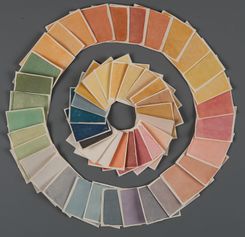Difference between revisions of "Ukiyo-e Print Colorant Database"
| Line 73: | Line 73: | ||
<span style="font-size:120%;><b>I</b></span> | <span style="font-size:120%;><b>I</b></span> | ||
| − | *[[:Category:Ippitsusai | + | *[[:Category:Ippitsusai Bunchō (一筆斎文調) active about 1765–1792|Ippitsusai Bunchō]] |
*[[:Category:Ishikawa Toyonobu (石川豊信) 1711–1785|Ishikawa Toyonobu]] | *[[:Category:Ishikawa Toyonobu (石川豊信) 1711–1785|Ishikawa Toyonobu]] | ||
*[[:Category:Isoda Koryusai (礒田湖龍斎) 1735–1790|Isoda Koryusai]] | *[[:Category:Isoda Koryusai (礒田湖龍斎) 1735–1790|Isoda Koryusai]] | ||
<span style="font-size:120%;><b>K</b></span> | <span style="font-size:120%;><b>K</b></span> | ||
| − | *[[:Category:Katsukawa | + | *[[:Category:Katsukawa Shunkō (勝川春好) 1743–1812|Katsukawa Shunkō]] |
| − | *[[:Category:Katsukawa | + | *[[:Category:Katsukawa Shunshō (勝川春章) 1726–1792|Katsukawa Shunshō]] |
| style="width:300px; text-align:left;" | | | style="width:300px; text-align:left;" | | ||
*[[:Category:Katsushika Taito II (葛飾戴斗) active about 1810–1853|Katsushika Taito II]] | *[[:Category:Katsushika Taito II (葛飾戴斗) active about 1810–1853|Katsushika Taito II]] | ||
| Line 96: | Line 96: | ||
<span style="font-size:120%;><b>R</b></span> | <span style="font-size:120%;><b>R</b></span> | ||
| − | *[[:Category: | + | *[[:Category:Ryūryūkyo Shinsai (柳々居辰斎) 1764?–1820|Ryūryūkyo Shinsai]] |
| style="width:300px; text-align:left;" | | | style="width:300px; text-align:left;" | | ||
| Line 110: | Line 110: | ||
*[[:Category:Torii Kiyonobu I (鳥居清信) 1664–1729|Torii Kiyonobu I]] | *[[:Category:Torii Kiyonobu I (鳥居清信) 1664–1729|Torii Kiyonobu I]] | ||
*[[:Category:Torii Kiyotada I (鳥居清忠) active about 1720–1750|Torii Kiyotada I]] | *[[:Category:Torii Kiyotada I (鳥居清忠) active about 1720–1750|Torii Kiyotada I]] | ||
| − | *[[:Category: | + | *[[:Category:Tōshūsai Sharaku (東洲斎写楽) active 1794–1795|Tōshūsai Sharaku]] |
*[[:Category:Totoya Hokkei (魚屋北渓) 1780–1850|Totoya Hokkei]] | *[[:Category:Totoya Hokkei (魚屋北渓) 1780–1850|Totoya Hokkei]] | ||
Revision as of 21:57, 7 April 2023
PLEASE NOTE:: This databasee is still in a DRAFT state. We are in the process of adding and correcting information
Since 2002, the MFA’s Asian Conservation Studio and Scientific Research department has been conducting research into the colorants used in Japanese woodblock prints, or ukiyo-e prints from the Edo period (1603-1868). Non-invasive techniques that do not require sampling from the prints have been used: X-ray Fluorescence (XRF), Excitation Emission Matrix (EEM) and Fiber Optic Reflectance (FORS) spectroscopies. The results were cross referenced with samples that were formulated and printed using organic and inorganic materials traditionally believed to have been used during the Edo period. Thus far, over 800 prints have been analyzed.
This Ukiyo-e Print Colorant Database is an effort to begin collating the analytical results of colorants used in Japanese woodblock prints from the Edo period (1603-1868) into one location that is accessible to all researchers. It currently focuses on prints from the MFA’s collection from the early 1700s to the mid-1800s. It does not yet cover the whole breadth of colorants used, such as the aniline based colorants, but we hope to continue to expand the database.
Colorants
A list of colorants detected so far in this research. Click to see examples of the printed colors, spectra, and a list of analyzed prints. More on the data.
|
Blue Red |
Yellow Brown Purple |
Green Black White |
Mica Metallic |
By Artist
Bibliography
A list of publications and resources on the identification of colorants in Japanese woodblock prints.
About the Collection
The MFA has over 50,000 Japanese prints and approximately 3,000 titles of illustrated books covering the Edo period (1603-1868) to the present. The Japanese woodblock print collection spans the Edo period from its birth to color printing to its height as a commercial product and to its end in the Meiji period (1868-1912). This collection represents not only the breadth of artists working at the time but also multiple impressions and editions, making it a comprehensive resource for scholarship, research, and teaching. Collections from prominent Bostonians such as William Sturgis Bigelow, Denman Ross, and the Spaulding brothers at the turn of the century form the basis of the collection. Furthermore, the William S. and John T. Spaulding Collection, which is comprised of over 6,000 prints, is available to researchers and educators as an important study collection. Because the Spaulding Collection is not exhibited, these prints generally display remarkable preservation of the colorants making it a valuable benchmark for the study of color and palette.
Acknowledgement
The colorant research comes out of a long collaboration between the Asian Conservation Studio and Scientific Research. We would like to thank the many volunteers who contributed to this research. We are also grateful to Richard and JoAnn Pinkowitz for donating to this database project which allowed us to bring the Ukiyo-e Print Colorant Database online.

